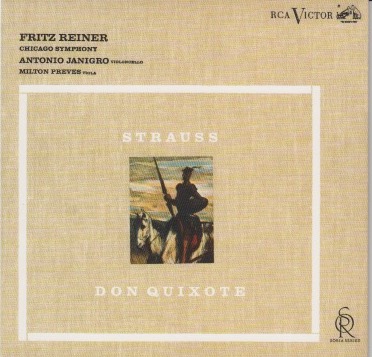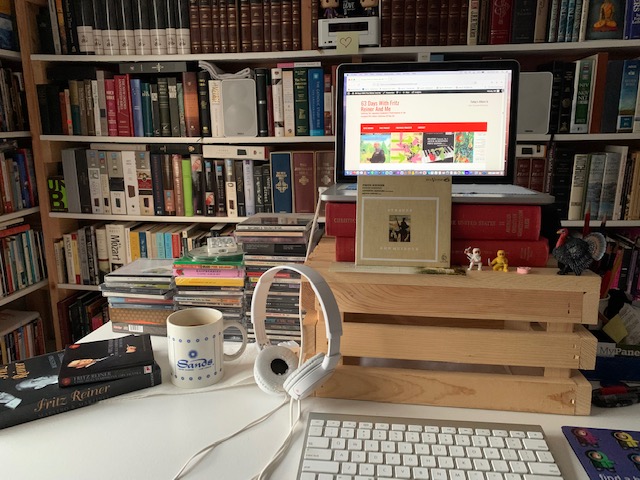
The first thing I noticed about today’s album is the cover, which is different from every other one so far.
I also noticed it doesn’t say “Living Stereo” or “Miracle Surface” or “New Orthophonic” High Fidelity Recording or anything other than RCA Victor in the upper right corner…and a phrase I’d never seen (or even heard of) before: Soria Series.
What’s a Soria Series?
I googled the phrase and discovered a few very fascinating things.
“Soria” is the last name of a person named Dorle Soria, whom – according to her bio on Wikipedia,
Dorle Jarmel Soria (December 14, 1900 – July 7, 2002) was an American publicist, producer of classical music recordings, and journalist. With her husband Dario Soria, she co-founded Cetra-Soria Records and Angel Records.
A graduate of Columbia University, she worked as a journalist before the concert manager Arthur Judson hired her to manage publicity for his company (which later became the talent management company Columbia Artists Management). She was press manager and publicist of the New York Philharmonic which Judson managed. She played a significant role in establishing the stature of Arturo Toscanini, then the music director, during the orchestra’s 1930 European tour. She promoted events such as Leonard Bernstein’s 1943 Philharmonic debut and the orchestra’s 1951 European tour. In 1942, she married Dario Soria, who had emigrated to the United States from Italy several years earlier.
In 1946, as part of her efforts at promotion at Columbia Artist Management, she co-founded with Nelson Lansdale Artist Life, a magazine intended for managers and other heads of music organizations and agencies. Columbia’s board of directors put an end to Artist Life in the fall of 1949, citing 6,000 readers but a deficit of between $6,000 and $7,000. When Boris Morros asked her opinion on which instrumentalist to include in his forthcoming film Carnegie Hall, Soria suggested the cellist Gregor Piatigorsky, not realizing that Morros had been one of Piatigorsky’s teachers.
In the 1960s, Dorle Soria wrote a weekly column for the Carnegie Hall concert programs. Never entirely abandoning her journalist training, she wrote for the magazines High Fidelity, Opera News, and Musical America for which she wrote a monthly column called “Artist Life” (the same name as her short-lived publication of the 1940s). In 1982 she authored a monograph titled The Metropolitan Opera: A Guide. A producer of the MET’s “Historic Opera” series, she received an award in 1986 for her work on issuing the 1939 broadcast of Simon Boccanegra on long playing records.
Dorle Soria died in New York City on July 7, 2002, at the age of 101.
Wow. That was one of the most fascinating and serendipitous discoveries yet in this exploration of Reiner’s RCA works. I had no idea a person named Dorle Soria ever existed, or that she contributed so uch to the arts – even to the film Carnegie Hall, which I wrote about on Day 17. The film was a discovery on that day, and it’s a discovery today that Dorle Soria contributed something to it.
Small world.
Or, big world and small discoveries.
Another small discovery: John Weicher, whom I wrote about on Day 2 (and suspected of playing on the album on Day 1), plays violin on today’s album, too. His name is not on the cover, however, even though the names of the viola player (Milton Preves) and the cellist (Antonio Janigro) are listed there.
The Objective Stuff
From his entry on Wikipedia,
Richard Georg Strauss (1864-1949) was a German composer, conductor, pianist, and violinist. Considered a leading composer of the late Romantic and early modern eras, he has been described as a successor of Richard Wagner and Franz Liszt. Along with Gustav Mahler, he represents the late flowering of German Romanticism, in which pioneering subtleties of orchestration are combined with an advanced harmonic style.
Strauss’s compositional output began in 1870 when he was just six years old and lasted until his death nearly eighty years later.
From its entry on Wikipedia,
Don Quixote, Op. 35 is a tone poem by Richard Strauss for cello, viola, and orchestra. Subtitled Phantastische Variationen über ein Thema ritterlichen Charakters (Fantastic Variations on a Theme of Knightly Character), the work is based on the novel Don Quixote de la Mancha by Miguel de Cervantes. Strauss composed this work in Munich in 1897. The premiere took place in Cologne on 8 March 1898, with Friedrich Grützmacher as the cello soloist and Franz Wüllner as the conductor.
The score is 45 minutes long and is written in theme and variations form, with the solo cello representing Don Quixote, and the solo viola, tenor tuba, and bass clarinet depicting his squire Sancho Panza. The second variation depicts an episode where Don Quixote encounters a herd of sheep and perceives them as an approaching army. Strauss uses dissonant flutter-tonguing in the brass to emulate the bleating of the sheep, an early instance of this extended technique. Strauss later quoted this passage in his music for Le bourgeois gentilhomme, at the moment a servant announces the dish of “leg of mutton in the Italian style”. Graham Phipps has examined the structure of the work in terms of Arnold Schoenberg’s ideas of ‘surface harmonic logic’ and ‘developing variation’.
Strauss was 33 when he composed this piece of music. It was recorded on April 11, 1959, in Orchestra Hall, Chicago. Maestro Reiner was in his 71st year.

The Subjective Stuff
Recording quality: 4 (mono?)
Overall musicianship: 5
CD booklet notes: 2
CD “album cover” information: 1 (very little on front or back cover, not even any minuscule type)
How does this make me feel: 3 (on the strength of John Weicher, alone)
I can’t get too excited about Richard Strauss.
However, I can get excited about violinist John Weicher, whom I have encountered several times already in this musical exploration.
I tend to notice the violin in Classical music. In fact, it was that instrument – in the hands of Sidney Harth – that prompted me to obtain Rimsky-Korsakov’s Scheherazade, Op. 35, which was the first Fritz Reiner/CSO album I ever purchased. I heard it one night on our local Classical music radio station (WBLV) and I had to have it.
Ever since then, I’ve been listening for John Weicher and Sidney Harth to appear again.
Sadly, not even John Weicher can instill enthusiasm in me for this performance.
This is interesting music. But nothing I’d ever want to hear again.
Tasteful and artistic album cover, though.
